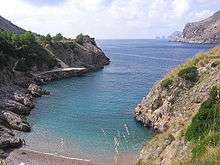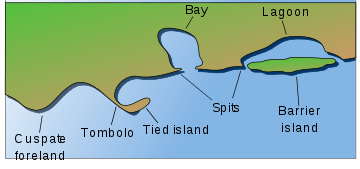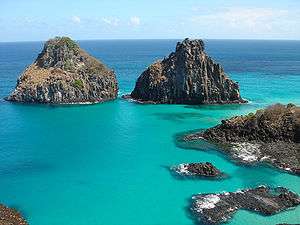Inlet
An inlet is an indentation of a shoreline, usually long and narrow, such as a small bay or arm,[1] that often leads to an enclosed body of salt water, such as a sound, bay, lagoon, or marsh.

Overview
In sea coasts, the term "inlet" usually refers to the actual connection between a bay and the ocean and is often called an "entrance" or a recession in the shore of a sea, lake, or river. A certain kind of inlet created by glaciation is a fjord, typically but not always in mountainous coastlines and also in montane lakes.
Complexes of large inlets or fjords may be called sounds, e.g., Puget Sound, Howe Sound, Karmsund (sund is Scandinavian for "sound"). Some fjord-type inlets are called canals, e.g., Portland Canal, Lynn Canal, Hood Canal, and some are channels, e.g., Dean Channel and Douglas Channel.
Tidal amplitude, wave intensity, and wave direction are all factors that influence sediment flux in inlets.[2]
On low slope sandy coastlines, inlets often separate barrier islands and can form as the result of storm events.[3] Alongshore sediment transport can cause inlets to close if the action of tidal currents flowing through an inlet do not flush accumulated sediment out of the inlet.[4]
See also
- Alaska Panhandle
- British Columbia Coast
- Calanque
- Inside Passage
- Ria
Notes
- "inlet". Dictionary.com. Ask.com. Retrieved July 6, 2014.
- Chen, Jia-Lin; Hsu, Tian-Jian; Shi, Fengyan; Raubenheimer, Britt; Elgar, Steve (2015-06-01). "Hydrodynamic and sediment transport modeling of New River Inlet (NC) under the interaction of tides and waves". Journal of Geophysical Research: Oceans. 120 (6): 4028–4047. doi:10.1002/2014JC010425. hdl:1912/7468. ISSN 2169-9291.
- Safak, Ilgar; Warner, John C.; List, Jeffrey H. (2016-12-01). "Barrier island breach evolution: Alongshore transport and bay-ocean pressure gradient interactions". Journal of Geophysical Research: Oceans. 121 (12): 8720–8730. doi:10.1002/2016jc012029. hdl:1912/8812. ISSN 2169-9291.
- Swart, H. E. de; Zimmerman, J. T. F. (2009). "Morphodynamics of Tidal Inlet Systems". Annual Review of Fluid Mechanics. 41 (1): 203–229. doi:10.1146/annurev.fluid.010908.165159.
References
- Bruun, Per; A.J. Mehta (1978). Stability of Tidal Inlets: Theory and Engineering. Amsterdam: Elsevier Scientific Pub. Co. p. 510. ISBN 978-0-444-41728-2. be pub co
External links
| Look up inlet in Wiktionary, the free dictionary. |
| Wikimedia Commons has media related to Inlets. |

